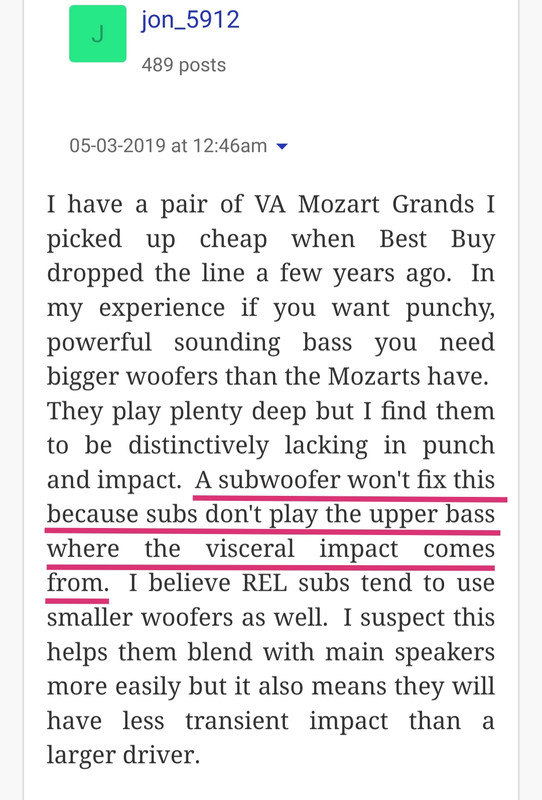@mijostyn --
Well put.
Ad 1). Don't see how that applies here. If subs are successfully implemented I'd only want them to reflect the variation in source material. It's about what becomes your "axis mundi" for setting the reference gain, and the rest really falls into place from here in my experience.
Ad 2). Sure, below the Schroeder frequency the resonating nature of sound waves becomes an important factor with regard to placement and how to avoid the most severe nulls and peaks. It can be a balancing act using both digital bass management and a more pure acoustical approach of placement and sub numbers. In my dual sub setup with a higher cross-over between the subs and mains, symmetry of placement is paramount, and corner loading, while not always ideal acoustically, lends itself naturally both with regard to proximity and symmetry to the mains, while also taking advantage of boundary gain. I could successfully add two more subs for an even smoother acoustical response, but that's for future plans to come.
Ad 3).
I'm guessing this is the potential rub many are confronted with here; leaving the mains running full-range and then trying to blend in subs (slightly overlapping or not) is really dealing with two separate systems - with all that entails.
I can understand some of the reasoning behind why many wouldn't want to employ a high-pass filter digitally over their passively configured main speakers, hereby adding another filter layer - albeit a sonically more transparent one compared to passive filters, to my ears - to an existing passive one, which is where I would suggest a more radical approach; without a HP running the mains full-range can integrate quite well with subs (I've used such a configuration years back), but my current approach high-passing the mains is done fully actively with a digital XO sans any passive cross-over, and as such is really dealt with as a 3-way system with the subs in close proximity to the mains. Every cross-over section, especially where horns are used, involves dealing with delay elaborately and eventually fine-tuned by ear, so the high-passing part of the mid-woofers is no different an aspect than high-passing the compression driver above them - or the subs for that matter just below the knee (i.e.: tune) to protect the drivers due to unloading. This is the radical nature I'm referring to above, because it's done considering the system incl. the (sub-)bass section as a whole.
Implemented as such remember the mid-woofers will be relieved of LF which, certainly when HP'ed above 70-80Hz, equates into a cleaner presentation and bigger headroom - up to 10dB's, even. That's significant and audible for the better when carefully implemented.
Ad 4). Why not take the next step and make it multiple larger subs?
Ad 5). I rarely encounter high-pass filters between subs and mains higher than ~125Hz. In my own setup the high-pass is set just below 85Hz, which is dictated by the upper end response of my tapped horns. I try to avoid extensive EQ'ing, but I guess I could stretch that HP a bit more towards 100Hz with some minor corrections.
Ad 6). It's delay settings galore on my Xilica DSP.
Ad 7). Using the ears is always the last measure here.
Ad 8). You still hear the half and quarter waves of a 20Hz tone in moderately sized listening room, albeit with lesser clarity vs. the full wavelength due to room interaction. 20-25Hz in not in vain by any measure in my moderately sized listening space.


